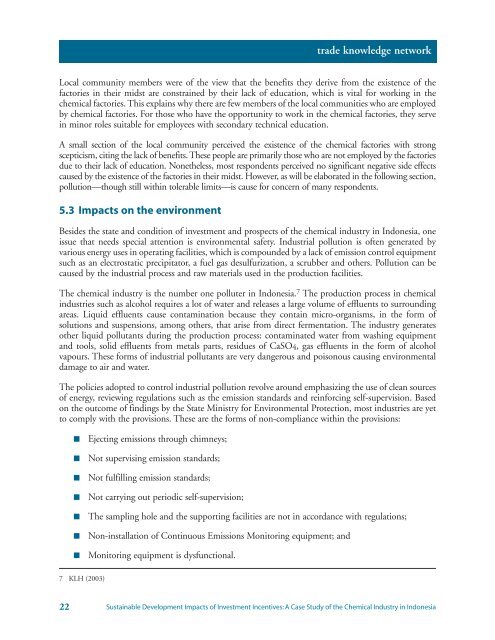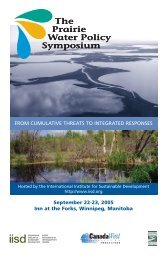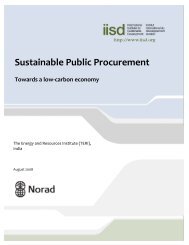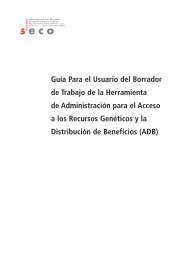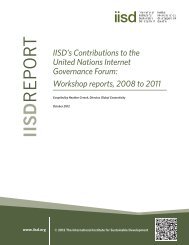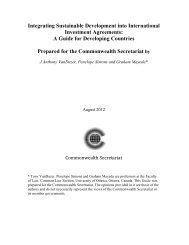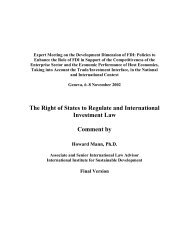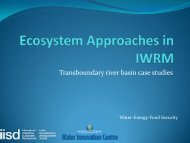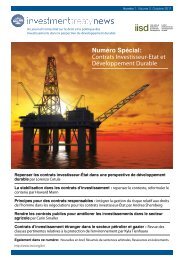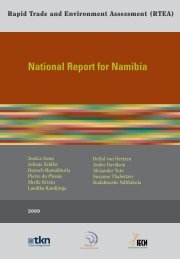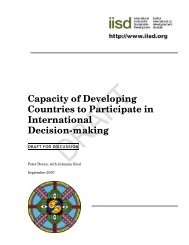Sustainable Development Impacts of Investment Incentives: A Case ...
Sustainable Development Impacts of Investment Incentives: A Case ...
Sustainable Development Impacts of Investment Incentives: A Case ...
You also want an ePaper? Increase the reach of your titles
YUMPU automatically turns print PDFs into web optimized ePapers that Google loves.
trade knowledge network<br />
Local community members were <strong>of</strong> the view that the benefits they derive from the existence <strong>of</strong> the<br />
factories in their midst are constrained by their lack <strong>of</strong> education, which is vital for working in the<br />
chemical factories. This explains why there are few members <strong>of</strong> the local communities who are employed<br />
by chemical factories. For those who have the opportunity to work in the chemical factories, they serve<br />
in minor roles suitable for employees with secondary technical education.<br />
A small section <strong>of</strong> the local community perceived the existence <strong>of</strong> the chemical factories with strong<br />
scepticism, citing the lack <strong>of</strong> benefits. These people are primarily those who are not employed by the factories<br />
due to their lack <strong>of</strong> education. Nonetheless, most respondents perceived no significant negative side effects<br />
caused by the existence <strong>of</strong> the factories in their midst. However, as will be elaborated in the following section,<br />
pollution—though still within tolerable limits—is cause for concern <strong>of</strong> many respondents.<br />
5.3 <strong>Impacts</strong> on the environment<br />
Besides the state and condition <strong>of</strong> investment and prospects <strong>of</strong> the chemical industry in Indonesia, one<br />
issue that needs special attention is environmental safety. Industrial pollution is <strong>of</strong>ten generated by<br />
various energy uses in operating facilities, which is compounded by a lack <strong>of</strong> emission control equipment<br />
such as an electrostatic precipitator, a fuel gas desulfurization, a scrubber and others. Pollution can be<br />
caused by the industrial process and raw materials used in the production facilities.<br />
The chemical industry is the number one polluter in Indonesia. 7 The production process in chemical<br />
industries such as alcohol requires a lot <strong>of</strong> water and releases a large volume <strong>of</strong> effluents to surrounding<br />
areas. Liquid effluents cause contamination because they contain micro-organisms, in the form <strong>of</strong><br />
solutions and suspensions, among others, that arise from direct fermentation. The industry generates<br />
other liquid pollutants during the production process: contaminated water from washing equipment<br />
and tools, solid effluents from metals parts, residues <strong>of</strong> CaSO4, gas effluents in the form <strong>of</strong> alcohol<br />
vapours. These forms <strong>of</strong> industrial pollutants are very dangerous and poisonous causing environmental<br />
damage to air and water.<br />
The policies adopted to control industrial pollution revolve around emphasizing the use <strong>of</strong> clean sources<br />
<strong>of</strong> energy, reviewing regulations such as the emission standards and reinforcing self-supervision. Based<br />
on the outcome <strong>of</strong> findings by the State Ministry for Environmental Protection, most industries are yet<br />
to comply with the provisions. These are the forms <strong>of</strong> non-compliance within the provisions:<br />
■<br />
■<br />
■<br />
■<br />
■<br />
■<br />
■<br />
Ejecting emissions through chimneys;<br />
Not supervising emission standards;<br />
Not fulfilling emission standards;<br />
Not carrying out periodic self-supervision;<br />
The sampling hole and the supporting facilities are not in accordance with regulations;<br />
Non-installation <strong>of</strong> Continuous Emissions Monitoring equipment; and<br />
Monitoring equipment is dysfunctional.<br />
7 KLH (2003)<br />
22<br />
<strong>Sustainable</strong> <strong>Development</strong> <strong>Impacts</strong> <strong>of</strong> <strong>Investment</strong> <strong>Incentives</strong>: A <strong>Case</strong> Study <strong>of</strong> the Chemical Industry in Indonesia


